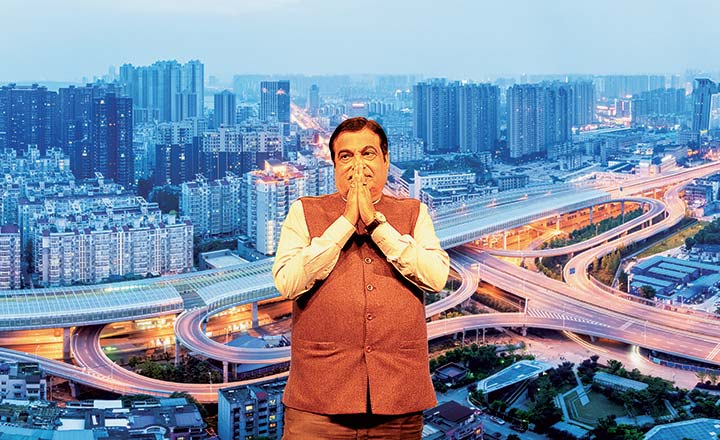Is there a slowdown or is there not? Thankfully it didn’t take the form of a Shakespearean soliloquy at Outlook Business Leading Edge 2019, because the biggest business leaders and union ministers debated two sides of the story, each as convincing as the other. The theme was why one should “Never Waste A Slowdown” and the responses were so varied that, at one point, business leaders quipped if they had “imagined” the slowdown. Even the not-so-politically correct minister of Road Transport and Highways and minister of Micro, Small and Medium Enterprise Nitin Gadkari chose to look at the bright side, laying out plans for a better future.
He reminded those in attendance that India remains the fastest growing economy, and “with 48% of export coming from MSMEs”. He believes this industry is the “growth engine of the country, contributing 29% to GDP”. But as unemployment in the country reaches unprecedented levels, Gadkari added that increasing the number of jobs is the most important item on the government’s agenda. Mind you, we have abundant manpower, but with changing times (digitisation and technological advancement), the Indian labour force needs a thorough shake-up.
“We have identified at least ten sectors that contribute to our exports and are building a scheme to support them for skill development training, research and product designs to upgrade the industry,” he said. The goal here is to facilitate higher exports. At the same time, high-import sectors will also be subjected to heavy rejig by encouraging more local production. The government will zero in on alternate options for imported goods, though the how of it is yet to be fine-tuned. The trade war between the US and China is one opportunity that India could take advantage of, he said. Once again, he chose diplomacy by not saying more about the long-drawn conflict between the two superpowers, as he didn’t “want to make more comments on it”. But, Gadkari reminded all that this is the time for Indian companies to boost exports to the US.
“Our leather industry exports to the US have increased by 8-10% ever since the trade war started,” he added. To paint a better picture of how India is emerging a winner from this trade war, a recent study by UNCTAD called Trade and trade diversion effects of United States tariffs on China, it was reported that the country gained about $755 million in additional exports to the US in the first half of 2019.

There is no lack of ambition, but nothing can be achieved without technological prowess and innovation. The government is cognisant of that. “We need to upgrade our manufacturing system by adding new machinery with the help of technology. New innovation and research across fields will make our products competitive,” added the senior BJP leader. How, you ask? By reducing three types of cost — logistical, capital and power. To that effect, 22 greenfield expressway projects have been proposed, which will be lit using solar power, electronic tolling system and a green cover of thousands of trees planted along the highway. One of these will connect the two capitals — political and financial — of the country, which is expected to “shorten road travel distance by 220 kilometres”.
“70% of the package is already awarded, and I am confident that we’ll complete this work within three and a half years,” the ‘flyovers man’ explained. This, he added, will allow truckers to make nine to 10 trips in a month between Delhi and Mumbai, as opposed to the current six to seven. To build world-class infrastructure, the roads ministry has planned #15 trillion investment in highways. But first, the banking sector needs work, Gadkari cautioned while lamenting that it is still difficult to get enough financing from bankers. “We need positive support from financial institutions for infrastructure development,” he added and said that he hopes to see more of that.
And as connectivity improves, Gadkari called upon all the business leaders present at the conclave to decentralise their industries and invest along the expressways, where land will be available at #8 million a hectare. He urged them to deliberate about the opportunities they could open up in rural and suburban areas, while also decongesting our metro cities. “Gurugram, Mumbai, Bengaluru and Pune are saturated. This is the time to think about new smart cities, areas to build airports, railway stations and new green cities,” he said, while rightly pointing out that despite constructing 55 flyovers and a #19 billion sea link, traffic conditions in Mumbai continue to worsen.
While the traffic in the City of Dreams chokes the streets, Delhi’s air chokes its people. The pollution level in the NCR region has been rising to never-before-seen levels, even prompting some entrepreneurs to cash in and launch “oxygen bars”. In fact, the Supreme Court likened the region to a gas chamber, slamming the centre for failing to curb stubble burning despite orders. To that, the minister said alternate fuel is the need of the hour. For instance, airlines could start testing biofuel aircraft like Spicejet has done. “We should think about technology that can reduce pollution — both air and water,” he added.
Gadkari then acknowledged there are economic problems, but affirmed that the government is implementing several reforms across sectors, with one eye always on creating more employment. On the lines of the conclave’s theme, the minister talked about how every problem can be converted into an opportunity, and any waste into wealth. He remains confident that India will continue to be a bright star and asserted that the government will always stand guard and support India Inc. Almost philosophically, he added, “Ups and downs are a part of life. There are problems because of a weak global economy, some because of demand-supply mismatch and some are just normal business cycles. But by positive attitude and development-oriented approach, I am confident that India will become a strong economic power.”











